Sea currents are horizontal water motions that occur on a large scale. They are from a few to several hundred kilometers wide and reach up to 2.5 km deep. They can be more easily compared to rivers in the oceans. And this is a nice comparison, considering that they have an unstable flow, they can twist, meander, change the direction and strength of the flow. To reflect their enormity, I can add that they carry up to 150 million cubic meters of water per second at a speed of up to several kilometers per hour.
Sea currents – division
Divide the sea currents as follows:
- surface currents
- wind currents – are the result of constantly blowing winds, where the air moves the water. Wind currents are most common (except mixed), especially in the trade wind zone, polar and medium altitudes, because constant and strong winds blow there.
- runoff currents – in places where many rivers flow into the oceans (fresh water has a different density than salt water) or there is high rainfall, or there is a lot of evaporation
- density currents – arise as a result of differences in water density at different depths, more often they occur in deep currents
- compensation currents – equalize the water level in the ocean, which has changed due to external factors, including constant winds
- mixed current
- deep currents
- bottom currents
Another division is warm, cold and indifferent. It only means the difference in temperature inside and outside the current – if the current is warm, then the surrounding water in the ocean has a lower temperature. In nature, nothing is simple, so the same current can be cold and then warm elsewhere, or it can be warm in summer and cold in winter. It can also flow only in one half-year 🙂 For example:
- cold currents – Antarctic Circumpolar Current, Canary Current, Peruvian Current,
- warm currents – Gulf Stream, Brazilian Current, Norwegian Current,
- periodic currents – Guinean Current (summer), Somali Current (summer), Equatorial Counter Current (winter)

Drift currents, upwelling and downwelling
Drift currents are an important phenomenon that affects all surface currents on Earth. These are sea currents arising as a result of trade winds and monsoons. Thus, they disrupt the oceans’ balance and force compensation currents, e.g. Equatorial Counter Current.
This creates a zone of divergence on the equator – surface water drains, and what replaces it? Waters from lower depths, i.e. equatorial upwelling. Similar to it and occurring on the western coasts of the continents (because they are taking the water of the trade wind west there) is coastal upwelling. And where does this water come from at lower depths? Somewhere at 55-60 degrees in both hemispheres, cold polar waters sink (downwelling) to the bottom of the ocean and travel towards the equator. As you can see, the ocean is one big bowl with still mixing and flowing water.

Impact of currents on nature and man
Contrary to appearances, currents affect the environment. Here are some examples:
- shipping – with the current you can sail faster and cheaper than against it
- fishery – thermophilic species and plankton meet at the intersection of hot and cold current, which prefers a cooler environment richer in oxygen, which results in a haven for fish and fishermen. Thanks to this, in South Africa, for example, the cold Benguel Current and warm Mozambique create good conditions for sharks.
- climate change – warm Gulf Stream / North Atlantic Current / Norwegian Current reaches high north, changing the climate of, for example, England to a more maritime and milder one. The crown example is the port of Murmansk, which, despite reaching far north, does not freeze all year round.


0 Comments for “Ocean water movements – sea currents”